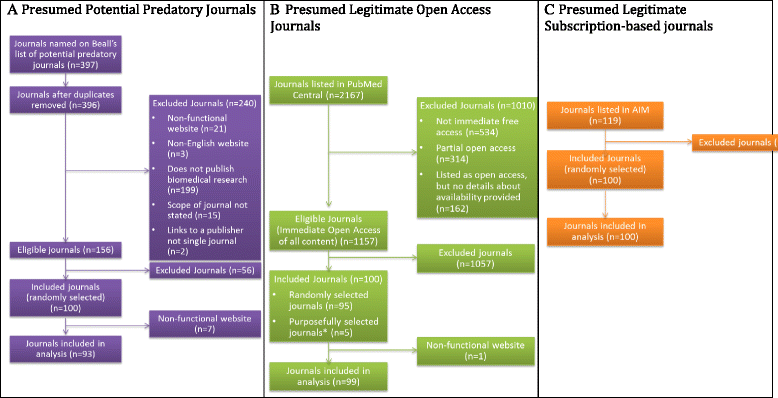Potential predatory and legitimate biomedical journals: can you tell the difference? A cross-sectional comparison
- PMID: 28298236
- PMCID: PMC5353955
- DOI: 10.1186/s12916-017-0785-9
Potential predatory and legitimate biomedical journals: can you tell the difference? A cross-sectional comparison
Abstract
Background: The Internet has transformed scholarly publishing, most notably, by the introduction of open access publishing. Recently, there has been a rise of online journals characterized as 'predatory', which actively solicit manuscripts and charge publications fees without providing robust peer review and editorial services. We carried out a cross-sectional comparison of characteristics of potential predatory, legitimate open access, and legitimate subscription-based biomedical journals.
Methods: On July 10, 2014, scholarly journals from each of the following groups were identified - potential predatory journals (source: Beall's List), presumed legitimate, fully open access journals (source: PubMed Central), and presumed legitimate subscription-based (including hybrid) journals (source: Abridged Index Medicus). MEDLINE journal inclusion criteria were used to screen and identify biomedical journals from within the potential predatory journals group. One hundred journals from each group were randomly selected. Journal characteristics (e.g., website integrity, look and feel, editors and staff, editorial/peer review process, instructions to authors, publication model, copyright and licensing, journal location, and contact) were collected by one assessor and verified by a second. Summary statistics were calculated.
Results: Ninety-three predatory journals, 99 open access, and 100 subscription-based journals were analyzed; exclusions were due to website unavailability. Many more predatory journals' homepages contained spelling errors (61/93, 66%) and distorted or potentially unauthorized images (59/93, 63%) compared to open access journals (6/99, 6% and 5/99, 5%, respectively) and subscription-based journals (3/100, 3% and 1/100, 1%, respectively). Thirty-one (33%) predatory journals promoted a bogus impact metric - the Index Copernicus Value - versus three (3%) open access journals and no subscription-based journals. Nearly three quarters (n = 66, 73%) of predatory journals had editors or editorial board members whose affiliation with the journal was unverified versus two (2%) open access journals and one (1%) subscription-based journal in which this was the case. Predatory journals charge a considerably smaller publication fee (median $100 USD, IQR $63-$150) than open access journals ($1865 USD, IQR $800-$2205) and subscription-based hybrid journals ($3000 USD, IQR $2500-$3000).
Conclusions: We identified 13 evidence-based characteristics by which predatory journals may potentially be distinguished from presumed legitimate journals. These may be useful for authors who are assessing journals for possible submission or for others, such as universities evaluating candidates' publications as part of the hiring process.
Keywords: Biomedical journal; Journalology; Open access; Predatory; Publishing models; Scientific publishing.
Figures

Similar articles
-
Predatory Publishing in Orthopaedic Research.J Bone Joint Surg Am. 2018 Nov 7;100(21):e138. doi: 10.2106/JBJS.17.01569. J Bone Joint Surg Am. 2018. PMID: 30399085
-
'Predatory' open access: a longitudinal study of article volumes and market characteristics.BMC Med. 2015 Oct 1;13:230. doi: 10.1186/s12916-015-0469-2. BMC Med. 2015. PMID: 26423063 Free PMC article.
-
Discriminating Between Legitimate and Predatory Open Access Journals: Report from the International Federation for Emergency Medicine Research Committee.West J Emerg Med. 2016 Sep;17(5):497-507. doi: 10.5811/westjem.2016.7.30328. Epub 2016 Aug 8. West J Emerg Med. 2016. PMID: 27625710 Free PMC article. Review.
-
Blacklists and Whitelists To Tackle Predatory Publishing: a Cross-Sectional Comparison and Thematic Analysis.mBio. 2019 Jun 4;10(3):e00411-19. doi: 10.1128/mBio.00411-19. mBio. 2019. PMID: 31164459 Free PMC article.
-
Ethical issues in publishing in predatory journals.Biochem Med (Zagreb). 2017 Jun 15;27(2):279-284. doi: 10.11613/BM.2017.030. Biochem Med (Zagreb). 2017. PMID: 28694719 Free PMC article. Review.
Cited by
-
Avoiding predatory publishing for early-career ophthalmologists.Indian J Ophthalmol. 2021 Dec;69(12):3719-3725. doi: 10.4103/ijo.IJO_1639_21. Indian J Ophthalmol. 2021. PMID: 34827029 Free PMC article.
-
How stakeholders can respond to the rise of predatory journals.Nat Hum Behav. 2017 Dec;1(12):852-855. doi: 10.1038/s41562-017-0257-4. Nat Hum Behav. 2017. PMID: 31024187 No abstract available.
-
Bibliometric characteristics of predatory journals in pediatrics.Pediatr Res. 2018 Jun;83(6):1093-1094. doi: 10.1038/pr.2018.54. Epub 2018 May 30. Pediatr Res. 2018. PMID: 29846367 No abstract available.
-
Supporting a definition of predatory publishing.BMC Med. 2020 May 8;18(1):125. doi: 10.1186/s12916-020-01599-6. BMC Med. 2020. PMID: 32380995 Free PMC article. No abstract available.
-
"Dear Doctor, greetings of the day!": A 1-year observational study of presumed predatory journal invitations.Prog Orthod. 2023 Jul 3;24(1):21. doi: 10.1186/s40510-023-00471-6. Prog Orthod. 2023. PMID: 37394538 Free PMC article.
References
-
- Bethesda Statement on Open Access Publishing. http://legacy.earlham.edu/~peters/fos/bethesda.htm. Accessed 31 Mar 2016.
-
- Morrison H, Salhab J, Calve-Genest A, Horava T. Open access article processing charges: DOAJ survey May 2014. Publications. 2015;3:1–16. doi: 10.3390/publications3010001. - DOI
-
- Crotty D. Is it True that Most Open Access Journals Do Not Charge an APC? Sort of. It Depends. The Scholarly Kitchen on WordPress.com. The Scholarly Kitchen. 2015. http://scholarlykitchen.sspnet.org/2015/08/26/do-most-oa-journals-not-ch.... 4 Apr 2016.
-
- Beall J. Beall’s List: Potential, Possible, or Probable Predatory Scholarly Open-Access Publishers. 2015.
-
- Beall J. Criteria for Determining Predatory Open-Access Publishers. 1st ed. 2012. http://wp.me/p280Ch-g5. Accessed 1 Apr 2014.
Publication types
MeSH terms
LinkOut - more resources
Full Text Sources
Other Literature Sources

